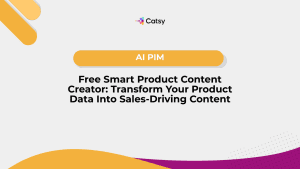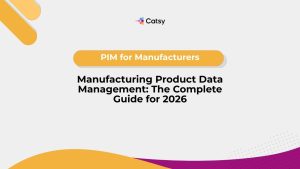5 Ways PDM Supercharges Your Product Development Cycle
Supercharge Your Revenue with PDM
- Ceejay S Teku
- October 13, 2025
- 11:15 pm

Table of Contents
Today’s e-commerce landscape is changing, and fast! It’s not enough just to innovate. Your success hinges on speed, accuracy, and on collaboration. If your company is involved in designing and engineering complex products that you ultimately produce, even the most seemingly minor inefficiency can cause delays and missed opportunities that will impact your revenue.
Enter PDM – Product Data Management. PDM is deliberately crafted to intentionally streamline your product development, ensuring that all of your processes are efficient … purpose-built for success.
Often, PDM is seen as a tech tool for engineers. But it’s much more than that! PDM is a strategic accelerator for the entirety of your product dev cycles. It guarantees that each version, file, and spec flows smoothly across your organization. Your teams can innovate faster and with fewer mistakes.
PDM also has the ability to customize your workflows and to integrate with other systems you may use. This enhances your efficiency throughout the entire development journey.
PDM supercharges your product development cycle, boosting your fuel pumps. It boosts efficiency and speeds up your results. Simply put, think of a positive displacement supercharger. It takes in a fixed amount of air per revolution and makes a significant impact on engine performance! Screw-type superchargers use screws to generate and regulate pressure, and that further enhances your efficiency.
Similarly, PDM energizes your workflows. It provides powerful, sustained improvements in your speed and output.
In this guide, we’ll examine five key ways that PDM enhances your product development process, helping your business bring better products to market … faster. With the right PDM solution, your company can more effectively achieve your product development and business objectives.
What Is PDM and Why It Matters for your Performance?
Before we hop into an explanation of the benefits, let’s clarify what Product Data Management (PDM) actually means. PDM is a system that will store and organize all of the data you own that’s attributable to your product line. This can include files like CAD models, designs, bills of materials, and even your daily documentation. PDM acts as a centralized source of truth for your teams, whether they be engineers, designers, or production staff. PDM enables the streamlined management and control of all of your product data.
The most critical data influencing a program’s performance potential is your company’s first-party data, which PDM leverages to optimize workflows and outcomes.
Note: Your PDM implementation is only as good as the data you own. Clean and structured data before implementation will help your process sail along more smoothly.
If you’re not using PDM, your data is probably scattered across drives, emails, and folders. Your teams are wasting hours searching for files, verifying versions, and recreating work they’ve lost. Product data management will eliminate this chaos by creating a digital environment in which:
Everyone can quickly access and work from the latest version or correct files.
Every change is tracked and documented.
Collaboration happens securely and in real time.
PDM software manages all of your files, components, and data that are involved in product development.
Today’s the day – start your journey with PDM to improve your data management and your workflow efficiency. With PDM, your teams can deliver personalized communications to customers by the very next day, ensuring relevance and engagement.
PDM is about much more than storing your data. It’s about building a smarter, faster, ultra-connected development cycle.
Let’s dive in!
1. PDM Reduces Time-to-Market - Power distribution module
The Challenge:
In today’s highly competitive marketplace, being the first to come market with a product will often determine who leads and who lags. Unfortunately, many teams (maybe yours) are losing weeks – even months – to disorganized data and version confusion.
The PDM Advantage:
PDM will significantly speed up your product dev timelines by removing obstacles at every stage. This simplifies processes for your teams. Let’s take a look:
Centralized Data Access: Engineers can instantly find the correct design files. This allows them to work efficiently – no more digging through email chains!
Automated Version Control: Everyone is now able to work from the latest version with accurate data. No more duplicate work caused by outdated files, thanks to automated workflows.
Streamlined Approvals: Integrated workflows accelerate reviews and make sign-offs faster. This means quicker design iterations from your teams. Your PDM will ensure that your project reach success more quickly, as your development is streamlined.
When each phase from concept to prototype flows seamlessly, your time-to-market shortens without compromising your quality. PDM can also boost your speed and efficiency because it enhances collaboration and reduces delays.
Real-World Example:
A mid-sized manufacturer using PDM might shorten its design-to-production cycle by 25 to 40 percent simply by cutting time wasted on finding, verifying, and redoing files. PDM can also help your teams monitor the progress of projects throughout development to ensure that each stage is optimized.
In a fast-moving market, PDM can transform your product velocity into a competitive edge, helping projects reach successful completion without unnecessary hold-ups.
2. PDM Enhances Collaboration Across Teams
The Challenge:
Modern product development rarely occurs in isolation. Engineers, designers, supply chain managers, and production teams all collaborate over the course of any given project. Without a unified system, collab becomes chaos – conflicting file versions and breakdowns in communication are the reasons.
The PDM Advantage:
PDM promotes cross-functional collaboration because you’re establishing a shared digital workspace. It also enables modeling of lookalike audiences based on first-party data, and this helps your teams expand your business’s reach to the customer while maintaining precision in their targeting.
Here’s how it improves teamwork:
Single Source of Truth: Everyone references the same data, which vastly cuts down on the confusion about which design or spec is current.
Controlled Access: Different departments can access relevant information without stepping on another team’s toes or duplicating efforts (and files).
Concurrent Engineering: Multiple team members are empowered to work on related components … simultaneously and without conflicts. Obviously, this supports parallel workflows.
Integration with CAD Tools: Engineers collaborate and run workflows directly within your CAD and PDM environments, saving time switching back and forth between platforms.
Automated Information Relays: PDM replaces manual relays of information by furnishing automated, reliable processes. Your data will be efficiently and accurately stored.
The result? Better coordination, fewer bottlenecks, and faster innovation.
Example in Action:
Imagine a global design team. They’ve got engineers in Chicago, suppliers in Germany, and manufacturers in China.
A PDM system will ensure that each of your stakeholders is working with the same data in real time. There’s no more confusion, miscommunication, or delay. Your teams can also document important changes, right as they happen.
By connecting everyone through structured product data, PDM provides the power to take collaboration from a challenge into a strength.
3. PDM Minimizes Costly Errors and Rework
The Challenge:
One of the most expensive problems in product development is error propagation. This is when a single incorrect version or data mismatch causes downstream production or procurement issues. Take steps to prevent this in order to avoid costly consequences.
Even tiny little mistakes like an outdated drawing or a mislabeled part can trigger expensive delays and rework – or, in the worst cast scenario, legal trouble or product recalls.
The PDM Advantage:
The answer to the challenge of error propagation in product development? PDM. Product data management helps to minimize costly errors by maintaining accuracy and traceability of data. Retargeting prospects with PDM will reinstate interest from individuals who have engaged with you before – no more lost opportunities.
Here’s how:
Automated Version History: Each and every change is logged with details on who made it, when, and why, making it easy to trace and correct errors.
File Dependencies: PDM tracks relationships among your files. If one part changes, dependent assemblies are automatically flagged to be changed, too.
Access Controls: Only authorized users can edit or approve critical files. This reduces the instance of accidental changes.
Audit Trails: Complete documentation supports compliance and quality assurance.
This control ensures that your teams are empowered to catch mistakes early… before production. It saves your time, your money, and your reputation.
By improving product data and workflow reliability, PDM helps maintain consistent and secure operations.
Example in Action:
A company without PDM might spend 20 to 30 percent of their budgeted engineering time fixing errors caused by poor version control. With PDM, that will drop significantly. Your teams can innovate – not firefight, and you can identify the root causes of errors to prevent them from repeating.
In short, PDM replaces guesswork with confidence.
4. PDM Boosts Efficiency in Design and Engineering Workflows
The Challenge:
Engineering productivity often suffers from repetitive, low-value tasks. Your employees may be hunting files, renaming versions, managing permissions, or manually creating documentation sheets. These add up, slowing your innovation.
The PDM Advantage:
PDM automates and streamlines these tasks. Your engineers can focus on what matters most – designing great products!
Key efficiency gains include the following:
Automated File Naming & Storage: PDM standardizes your file naming and storage, ensuring consistency across each of your projects.
Integrated Workflows: Common processes like your design approvals, change requests, or BOM updates are built-in now. Collaborating with a PDM partner can further streamline and automate design and engineering processes, enhancing workflow integration and efficiency.
Data Reuse: Your engineers can now easily search and reuse your existing designs without starting fresh.
CAD Integration: PDM will seamlessly connect with tools like SOLIDWORKS, Autodesk, and Siemens NX. Your data management is embedded directly within the design environment.
With fewer manual steps and faster data access, your design cycles will become leaner, more repeatable, and more productive.
Example in Action:
An engineering team was spending hours just managing file versions. With PDM, that time can be better spent developing and refining products. Your efficiency gains multiply across multiple teams. In addition, PDM will facilitate customer retargeting. This enables your brand to better engage your existing customers with tailored marketing messages.
Streamlined workflows mean your organization can achieve more with the same resources. This is a critical edge in competitive markets! The time you’ll save with PDM results in more opportunities for your business.
5. PDM Enables Better Decision-Making with Data Visibility
The Challenge:
Product development decisions, whether they regard design, budget, or any other aspect of your business, rely on accurate information. When your data is siloed, leadership will often base decisions on outdated or incomplete info. Segmenting your customer data in a CRM can significantly impact your marketing performance using PDM strategies, ensuring decisions are data-driven and, most importantly, effective.
The PDM Advantage:
PDM gives you the power to consolidate all of your design and engineering data into one place. This delivers complete visibility to your teams throughout the entire product cycle.
This transparency supports better decisions by offering:
Data-Driven Insights: Teams can analyze historical data to spot inefficiencies or common error sources.
Traceability: Understanding how and why changes occurred will help your teams make informed improvements.
Seamless Integration: PDM data can feed into your PLM (Product Lifecycle Management) or ERP systems, offering the powers that be a full picture of your product and process performance.
Compliance and Audit Readiness: Centralized records simplify your reporting and help keep you compliant.
When everyone, whether they be engineers or execs, can access accurate product data any time they need to, decisions become faster, smarter, and more strategic.
How PDM Fits into a Connected Product Ecosystem
PDM is part of a larger product data ecosystem that links engineering with your business and marketing systems. In this ecosystem, PDM acts like a supercharger to enhance the flow and efficiency of your product data across each and every department.
Here’s its role:
PDM manages your product design data during the development phase.
PLM oversees the entire product lifecycle, from concept to retirement.
A PIM (Product Information Management) like Catsy’s PIM platform prepares finalized product data for your teams, ensuring accurate and consistent info across each of your channels.
DAM (Digital Asset Management) stores and distributes related assets like your images, videos, and spec sheets.
In the same way that a power distribution module will provides direct control over vehicle components, a PDM offers you versatile management over your different data components.
Together, these systems create a digital thread: a connected data flow that ensures consistency and accuracy from the design stage to the customer-facing product.
At Catsy, we help companies like yours bridge the gap between engineering data and customer-facing product information. When you partner with a PDM vendor, you optimize your product data ecosystem, ensuring seamless collaboration and efficient data flow.
Using first-party data strategically in a PDM setting can supercharge your brand’s performance throughout the entire lifecycle… it’s a cornerstone of modern product management.
The ROI of PDM: Real Business Impact
Implementing PDM is more than a technical upgrade. It’s a business strategy that offers a measurable ROI. Companies that adopt PDM systems will experience:
A 30 to 50 percent reduction in product development cycle times.
20–40 percent fewer errors in design handoffs.
Up to 70 percent faster file retrieval times.
Improved compliance and audit readiness.
Higher employee satisfaction – there are fewer manual tasks now, and clearer collaboration is enabled.
With detailed PDM data, companies also have the power to create special offers tailored to customer needs; as you’d imagine, this drives engagement and boosts customer loyalty.
PDM helps your brand stay top-of-mind. It supports personalized, timely communications that will boost brand recall and improve customer retention.
A penny saved is a penny earned, and a minute saved in production is a minute earned for growth. Start your journey to measurable ROI – implement PDM today! Improved processes encourage your customers to return to you over and over, enhancing your long-term success.
Key Takeaways
PDM accelerates your time-to-market because it eliminates workflow friction and eliminates version confusion.
Collaboration improves as your teams can now work from a single, accurate source of truth.
Errors and rework decrease, protecting your payroll budget and the associated costs of human error.
Design efficiency rises through automation and CAD integration.
Visibility improves so you are enabled to make smarter, data-driven decisions.
Final Thoughts
In the innovation race, it’s not enough just to design great products. You need the power to design them efficiently, confidently, and with ample collaboration.
Product Data Management (PDM) gives your shop that advantage. By centralizing your design data and enabling collaboration, PDM turns your data complexity into universal clarity.
When your PDM foundation connects with PIM and DAM solutions like those offered by Catsy, your organization doesn’t just build great products. You create a seamless product experience that delights your customers faster and with greater impact. This drives digital transformation across your business.
Ready to streamline your entire product lifecycle with Catsy as your PDM Partner?
Discover how Catsy’s PIM + DAM system will complement your PDM to create a unified, efficient, and scalable product data ecosystem.





